Everything I learned in 30 years at Microsoft Part II
It's not what you know, it's who you know.
The origin of that phrase goes back to 1914 and the electricians union, namely Frank Duffy the union president, who, while fighting for fair wages and equal treatment, confessed the people who got ahead usually knew someone:
Many devious forces apparently also control the conditions of advancement and preference, and a phrase that is often heard is to the effect that it’s not what you know that counts so much, as who you know!
Electricity was cutting edge tech at that time, and electricians were highly sought after. But this wasn’t the first time success depended on who you sat next to.
Humanity is tribal, go back another 100,000 years or so, your network was your tribe and every night you gathered with them around the fire to eat meat and share knowledge. Fire was the most powerful technology of all back then, and it was clear that without the support of your tribe and the warmth of that fire you wouldn’t last long on your own.
As an aside, the lure of fire still runs deep. No matter how hot or wet it is, campers will gather around the fire sucking smoke and roasting marshmallows with their tribe a lot like we did 100,000 years ago.
Arnold Neustadter was the first person to attempt to organize your business network. Before he invented the Rolodex, he came up with the Swivodex (an inkwell that wouldn’t spill) and the Autodex (a spring operated alphabetical address book). Arnold was a New York City entrepreneur and these were all products of his wonderfully named Zephyr American Corporation, but it was the Rolodex that took off.
A full Rolodex was a sign of influence and power.
Fire led to electricity which led to yes, computers and without giving Mark Zuckerberg too much credit — the one original thing he did was recognize the power of the tribe and build it online. Facebook started as a place to connect with your friends when you can’t be with them around that communal fire. Social Networks extended to sharing what your friends liked and what they were doing and your online tribe grew that way.
The tribe around the fire and online represents strong ties. People in your family, close friends, people you went to school with, people you work side-by-side with.
However, in the 70’s Sociologist Mark Granovetter published an article in The American Journal of Sociology called The Strength of Weak Ties.
Weak ties are acquaintances rather than close friends, people you know indirectly, outside your core tribe. Granovetter’s results were striking — it was those connections — the weak ties that had an outsize influence in areas like career progression.
…weak ties, often denounced as generative of alienation are here seen as indispensable to individuals’ opportunities and to their integration into communities; strong ties, breeding local cohesion, lead to overall fragmentation …
Stay only inside your tribe and it gets insular. However, weak ties connect you to new tribes.
I escaped public sector jobs through a weak tie — someone I met on an outsourced project got me into a boutique consulting firm. My first Microsoft job came the same way — an acquaintance who managed a partner opened that door.
Business schools eventually formalized this. They called it Networking (in my MBA stint I hated it). Reid Hoffman took Granovetter’s findings and turned them into a business model. LinkedIn’s engine is those 2nd- and 3rd-degree connections. Recruiters and job seekers know it works and that’s where they make their money.
Inside Microsoft I jumped around the org the same way. Each move came through an acquaintance I’d worked with across teams. These weren’t best friends. They weren’t in my core tribe, but they were bridges. Weak ties let you cross into new territory.
Recognize them, cultivate them and don’t burn them. Because you never know which connection will lead you to Kevin Bacon.


